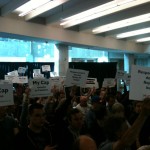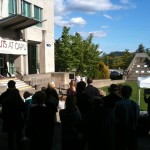
Community action against the cuts and the politics they represent was swift and effective as Capilano University’s Board of Governors rejected the proposed budget and requested that the University administration propose a new one that does not require any program cuts. Consequently, the Senate Budget Advisory Committee went to work on a new proposal. This op-ed outlines some of their findings and alternative ideas:
Capilano University has the same number of faculty members it did in 2009, but serves more than 1000 additional full-time equivalent students. However, the efficiency gains made by faculty have been consumed by the institution’s operating, administrative, and IT costs, which have all expanded by over 40 percent in just four years.
To pay for themselves, administrators want to cut seven percent of the university’s programs to shave one percent off the bottom line. To protect their bloated bureaucracy, they want to eliminate unique and acclaimed programs, reduce opportunities for students, and shrink the university’s revenues.
Our alternative? Continue to nurture Cap’s diverse and accessible program mix by pursuing modest reductions to administrative overhead and expenses, with a return to pre-2012 spending levels. This would cover the current shortfall and allow us the time we need to find longer-term solutions.
Are these radical suggestions? We think not. In fact, the B.C. Universities Act gives faculty broad management power—for example, as stated in Part 8, paragraph 40: “subject to this Act and to the approval of the senate”, faculty may “make rules for the government, direction, and management of the faculty and its affairs and business.”
On June 11, 2013, the Board of Governors of Capilano University voted (11:2, one abstain and one spoiled ballot) to accept without amendments the Budget put forward by the President which included the course cuts and program intake suspensions that were a part of the original, contested budget of May 14.
Many people believe that this budget and the process that led up to it is in violation of the University Act. In the words of the Capilano Faculty Executive “This is now political”. There is lots to do.
The cuts for the Fall semester of 2013 are now inevitable, but the future is still unfolding.
That future is still unfolding with ongoing protests against the cuts, letter writing campaigns to MPs, MLAs and the Premier, and strong community organizing activities. So, it is in solidarity that Social Alterations is posting both this update and this call for entries from the Capilano University Textile Arts Department asking students and alumni to submit images for an upcoming exhibit.
The Educational Issues Committee is organizing a show of the Programs. The installation is meant to highlight and display how wonderful the program are, and demonstrate the extent of what the institution and students are losing by cutting these programs! We are looking for images that highlight the skills students develop in the programs, and the amazing work which is created. The photos are going to be blown up, (we will be adjusting the DPI) and printed to around 3ft by 4ft, photos will be hung in an installation within the CSU buildings, there will also be a series of smaller photographs displayed. If anyone has great photographs or images of projects that they feel represent the program, and would like to share them with us for the display.
We are also looking for a caption for each program to go with the photos. Something that not only highlights the amazing knowledge and skills that students develop through the program, but states what the community and students will be losing if these programs disappear.
Please send to : jokeeffealmo@gmail.com
This struggle is yet another example of the undervaluation and devaluation of the arts in education. There is a serious deficit in our values when we begin to dismiss the importance of a robust and creative environment that nurtures and supports open and diverse artistic and cultural expression. This devaluation is a process that reflects the shift in power relations at universities to a top-down corporate model of governance that ignores community concerns including those of the students who pay tuition and the educators who work hard to improve their institution’s reputation and competitiveness. It’s time for a reevaluation of priorities.
In solidarity,
Social Alterations
For more on the struggle against these cuts and how you can help even if you’re not Cap students or alumni:
Capilano University Textile Arts Department
Studio Art and Textile Art Eviction from Capilano University









